Unsure about your French table manners? Click Here to download > > How to avoid these 10 food etiquette mistakes !
- Home ›
- Ze French ›
- Holidays & Traditions ›
- Christmas Markets
14 Unique Christmas Markets in France - Unlike The Rest
Updated 19 November 2025 by Leyla Alyanak — Parisian by birth, Lyonnaise by adoption, historian by passion
This guide explores some of the most unusual Christmas markets in France — places that stand out: some are centuries old, others are recent inventions, but each one offers something you might not find anywhere else.
France hosts hundreds of Christmas markets each year, but only a handful qualify as truly unusual.
If you’re planning a winter trip and want something less commonplace, this guide brings together the most unique Christmas markets France offers, from icy cathedral squares to driftwood forests and sustainable, handmade fairs.
Whether you’re choosing between Strasbourg and the Colmar France Christmas markets or looking for smaller towns with character, these destinations show how varied the season can be.
Planning your trip? You can already book your train tickets (prices rise fast in December), compare winter hotel stays in France, or check Christmas market day tours from Paris.
Most travelers plan their December visit around the biggest Christmas markets in France, yet many of the most memorable ones are smaller or take place in lesser-known cities. Several are easy day trips from Paris, others sit deep in Alsace or along the lakes and mountains, but all bring their own traditions to the season.
- 1. Rouen: The Iciest
- 2. Roubaix: The Most Sustainable
- 3. Tuileries, Paris: The Most Ghostly
- 4. La Défense: The Most Urban
- 5. Reims: The Most Sacred
- 6. Strasbourg: The Oldest
- 7. Colmar: The Most Magical
- 8. Kaysersberg: The Most Artisanal
- 9. Mulhouse: The Best Dressed
- 10. Montbéliard: The Most Eclectic
- 11. Évian: The Most Fairy-Like
- 12. Lyon: The Most Artistic
- 13. Aix-en-Provence: The Most Provençal
- 14. Bordeaux: Banking on Social Issues
NOTE: Pages on this site may contain affiliate links, which support this site. See full Privacy Policy here.
If you think you know all the best French Christmas markets, France will surprise you.
You have the obvious variations – size, speciality and story focus – but there are several markets that stand out because they are the most unusual of their kind.
Take Strasbourg, for example: it is France's oldest and largest Christmas market, or Lyon, which is the most artistic, with eye-popping multi-colored creations.
Yet others are famous for different reasons — amazing lighting, an offbeat theme or simple beauty and ambience.
Many also happen to be located in fantastic French cities, which you can enjoy at a time of year when the crush of summer tourists is over.
The one-of-a-kind Christmas markets France does best
These beautiful Christmas markets are not listed in order of preference, but geographically: I start in the northwestern corner of France, then work my way east in an arc to Paris, then down eastern France, ending up in the least wintry part of the country, Provence.
Many of these destinations, especially in Northern or Eastern France, can easily be visited on a day trip from Paris.
So let's start with...
1. Rouen: the iciest
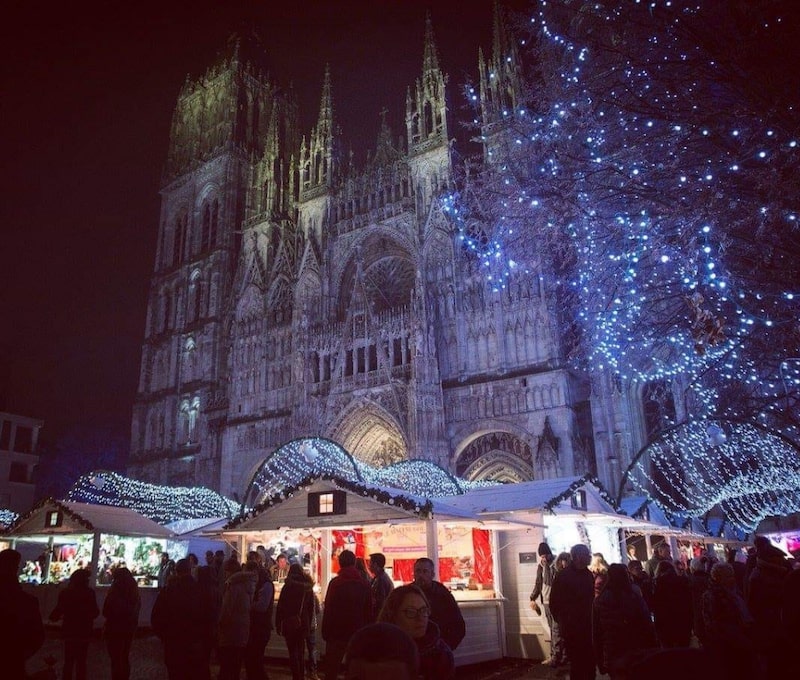 Thousands of tiny twinkling lights imitate the falling snow for that truly icy feeling.
Thousands of tiny twinkling lights imitate the falling snow for that truly icy feeling.Christmas should be cold, right? Rouen in Normandy certainly thinks so.
Each year, it goes over the top with Christmas decorations that re-create a cozy winter chill in honor of the season, which is one of the reasons this market is called La Givrée, the "icy".
The iciness of Christmas should be counterbalanced by... warmth. This Christmas market goes overboard in that direction, with its hot wines and spicy foods.
The name, however, means more than ice. Because givrée in French also means... a little nuts. I'm not sure the city fathers had this in mind when they thought this up but to me, that's really what puts this market at the top of my list. Anything with this whimsical a name has got to be great fun.
Not to mention the setting... at the foot of Notre-Dame Cathedral, painted so often by Monet!
Beyond the market, Rouen itself is worth a visit:
- the historic center is architecturally stunning
- there are plenty of reminders of Joan of Arc (who died here)
- it is the capital of impressionism, and
- Rouen cathedral is magnificent.
Here's the market's official website.
ROUEN HAS AN OFFBEAT SIDE
Yes, we know Rouen is where Joan of Arc's funeral pyre stands, and it is a well-visited site. But what you may not know is that the heart of Richard the Lionheart is kept in this city's cathedral.
This particular Richard, despite his saintly reputation, was actually quite violent, throwing himself into the Crusades with a lust for battle.
But one qualification that might cement Rouen's importance may not be what you expect: it is the site of the Nutella plant! This is where the world's Nutella is shipped from, in case you've taken a fancy to this paste (I have not). But it is a national institution in France: each SECOND, we eat 2.7kg of Nutella; that's 230 tons, or a million jars, if you prefer. Made with Normandy milk, of course.
🎄Rouen Christmas market 2025 starts Friday 21 November and ends Sunday 28 December.

2. Roubaix: the most sustainable
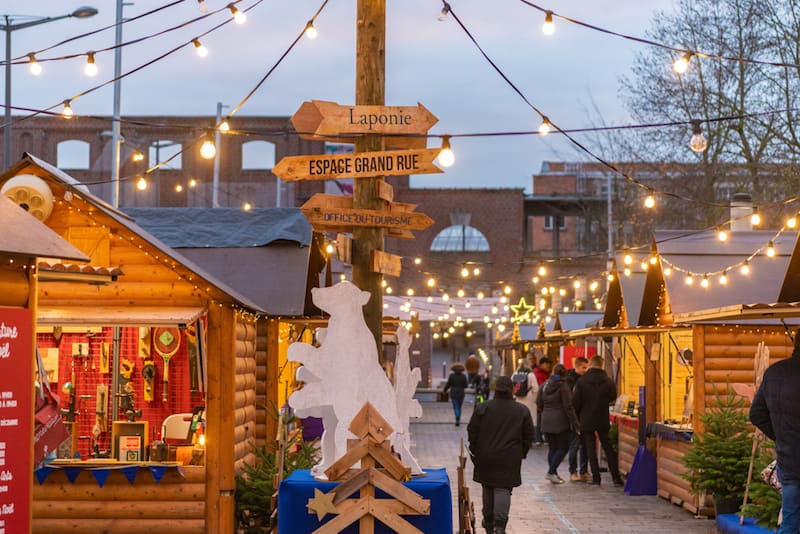 France's first sustainable Christmas market by Anaïs Gadeau, Ville de Roubaix
France's first sustainable Christmas market by Anaïs Gadeau, Ville de RoubaixThese days, there is much talk of sustainability and of eliminating waste, especially as our planet takes a beating from fires and floods and unusual climate events.
Sandwiched between the city of Lille and the Belgian border, the former textile center of Roubaix in the north of France may seem an unlikely candidate as France's premier zero waste pioneer.
Yet it is a badge Roubaix wears with pride, so much so that since 2014 it has hosted France's first sustainable Christmas market.
Here, all products are locally made, usually by hand, and often from recycled materials. Even the Christmas chalets are sustainable and are reused each year.
If you are keen to preserve the environment and dislike waste of any kind, this is the Christmas market for you. Not to mention how attractive it is...
AN INDUSTRIAL HERITAGE
Like many mono-industrial cities, in this case textiles, Roubaix suffered with industrialization and the city deteriorated. It has gained new life with the recognition of its many historical monuments and its nomination as a City of Art and Culture, an architectural label awarded by France's Ministry of Culture.
Many of these monuments are religious, as is the case throughout France, but a fair share is industrial, with the conservation or restoration of former manufacturing plants and promotion of an industrial heritage.
🎄Roubaix Christmas market 2025 takes place on weekends from Friday 28 November to Wednesday 24 December.


3. Paris Christmas at the Tuileries: the most ghostly
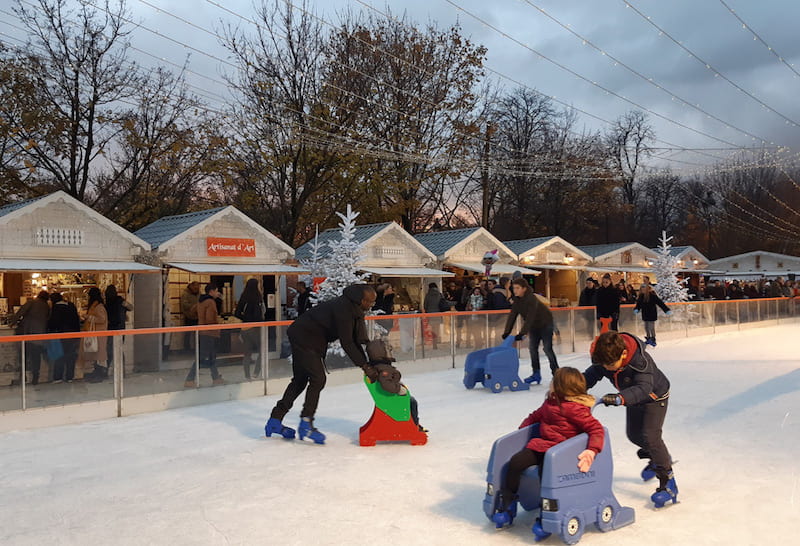
It's a leap from the small town of Roubaix to Paris, the capital of France, but the Christmas spirit isn't any different.
There are many Paris Christmas markets, but the Tuileries, for many, is one of the most popular and best Christmas markets in Paris.
It is held, as the name might indicate, in the Tuileries Gardens, just in front of the Louvre Museum, and replaces the Champs Elysées Christmas market.
What not many people know is that the Tuileries Gardens are home to a phantom, a little man dressed in red. According to the legend, this phantom is the soul of Jean the Butcher who worked near the Tuileries in the 16th century.
Jean the Butcher was assassinated on the orders of Queen Catherine de Medici because he knew too many crown secrets.
After his death, the ghost terrified occupants of the Tuileries Palace, always announcing a tragedy just before it took place.
The phantom of the Tuileries has been quiet since the palace was burned down in the late 19th century.
But the Tuileries Christmas Market is open until late at night, so does that mean we are going to wake him up again?
Where to stay near the Tuileries: Compare hotels around the Louvre and Place de la Concorde for evening visits to the market.
A CLOSER LOOK AT THE TUILERIES
The Tuileries Garden once belonged to the Tuileries Palace, built by Catherine de Medici but burned down during the Paris Commune in 1871. It served as the Paris home to many of France's rulers. The name tuileries comes from the tile factory (tile = tuile) that once occupied the former palace.
Despite the palace's disappearance, the gardens survived and thrived.
Under a series of kings, emperors and civilian leaders, the park was reshaped, enlarged, bombed, refashioned, sculptures were added, corners were cordoned off... and today, the Jardin des Tuileries stretches from the Louvre to the Place de la Concorde, a welcome island of greenery in the French capital.
In summer, seats are scattered throughout for those who want to relax for a bit next to one of the two ponds and reminisce about the illustrious strollers that once populated its paths.
🎄Paris Tuileries Christmas market 2025 takes place from Saturday 15 November 2025 to Thursday 4 January 2026.

VISITING FRANCE'S CHRISTMAS MARKETS
- Make sure you book your train tickets early - they sell fast and prices go up quickly.
- For cozy winter stays, I use booking.com for their flexible cancellation policies.
- If you're renting a car to reach the smaller markets, compare prices on Discovercars.
- If you'd rather take a tour, check out these Christmas market tours for 2025.
4. Paris La Défense: the most urban
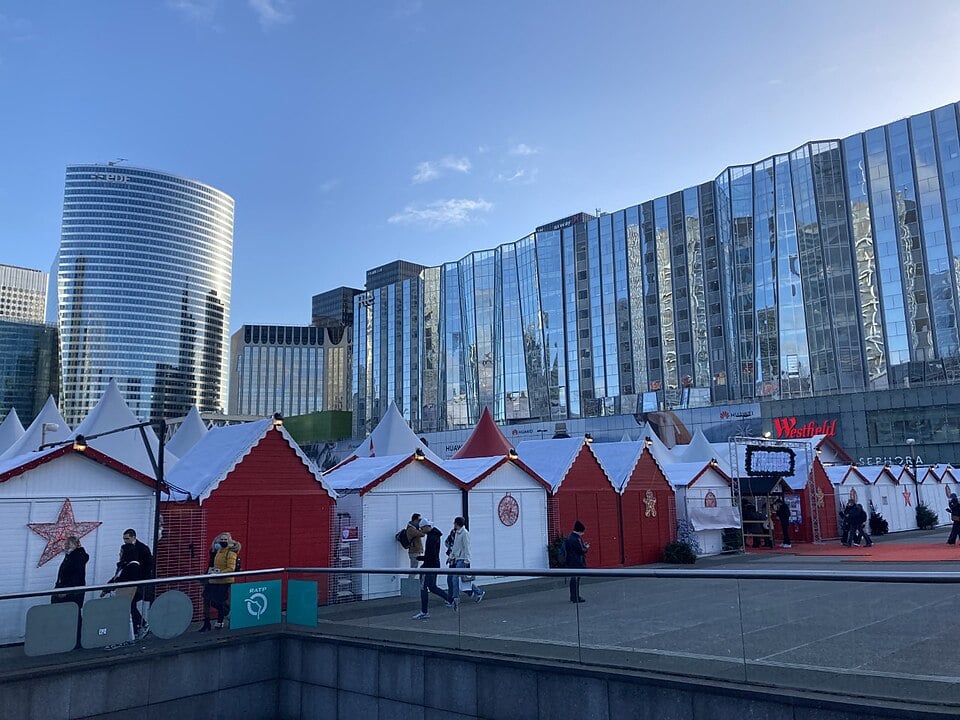 Christmas market in the heart of La Défense, Paris's modern business quarter. Photo Thomon CC BY-SA 4.0, via Wikimedia Commons
Christmas market in the heart of La Défense, Paris's modern business quarter. Photo Thomon CC BY-SA 4.0, via Wikimedia CommonsJust west of central Paris, at the edge of the business district, rises one of the most surprising Christmas markets in France.
At La Défense, wooden chalets line the giant esplanade at the foot of the steel and glass towers, creating the most contemporary Christmas scene in the country.
This is France’s largest Christmas market, with more than 300 chalets spread across the plaza. It draws an unusually international group of artisans – Nordic ornaments, Eastern European woodwork, Canadian maple products, and regional French specialties vie for space.
The contrast between the ultra-modern surroundings and the classic holiday stalls makes the experience unlike any other Christmas market in France.
The market atmosphere extends late into the evening, when office workers, families and visitors hop between chalets after work. It is busy, energetic and very different from the postcard villages of Alsace – which is precisely why it is one of the more unusual French Christmas markets.
Find out more from their official website.
Where to stay in La Défense: Compare hotels near the Esplanade or Grande Arche if you prefer modern architecture and easy Métro access.
A CLOSER LOOK AT LA DÉFENSE
La Défense may seem like an unlikely Christmas destination, but this business district is a key part of Paris’s post-war architectural history. Conceived in the mid-20th century to move offices out of central Paris, it has grown into the largest purpose-built business district in Europe.
At its heart stands the Grande Arche, inaugurated in 1989 as a modern version of the Arc de Triomphe. The district’s raised esplanade was designed as a pedestrian zone from the start, which makes it ideal for large-scale outdoor events like this market. Despite the steel-and-glass setting, La Défense has become one of the capital’s most visited winter spots.
🎄La Défense Christmas market 2025 takes place from Thursday 13 November – Sunday 28 December 2025.

5. Reims: the most sacred
 Glorious illuminations of Reims Cathedral. This particular artwork is Regalia by Moment Factory. Photo by Cyrille Beudot-Office de Tourisme du Grand Reims
Glorious illuminations of Reims Cathedral. This particular artwork is Regalia by Moment Factory. Photo by Cyrille Beudot-Office de Tourisme du Grand ReimsIf Reims (sometimes spelled Rheims in English) is deemed the most sacred, it is because the market draws a circle around the cathedral, which is brightly lit for the occasion.
The cathedral, as you may know, is famous for being the place where the kings of France were traditionally consecrated. This is where Joan of Arc (known in France as Jeanne d'Arc) would bring Charles VII for his own coronation in 1429.
While the vin chaud, or hot mulled wine, will keep you warm this Christmas season, do remember that you are in the heart of Champagne region, and we know Champagne is best sampled cold. Very cold. You won't have any trouble finding some here.
Click through to the Reims Christmas Market official site.
JOAN OF ARC AND THE CATHÉDRALE DE REIMS
Back in the early 15th century, a young woman of 17 heard a call to go fight and help France during the 100 Years' War.
She managed to wrangle an audience with the future King Charles VII and made some astounding predictions, including the future consecration of the king at Reims. Enthralled, Charles assigned her an army and she won battle after battle against the English.
Finally, in July 1429, Charles was crowned in the cathedral, with Joan looking on.
Sadly, things didn't end too well for her. She was discredited by palace intrigues, captured by the Burgundians (Burgundy was not a part of France yet), tried and found guilty of heresy (and of wearing men's clothes), and sold to England. Eventually, after jailing and torture, she was burned alive on a pyre in the city of Rouen.
King Charles never came to her rescue, even though he owed her his position. He somewhat redeemed himself by agreeing to a second trial 25 years later, which reversed her earlier guilty verdict. She was canonized as a Catholic saint in 1920. Better late than never?
🎄Reims Christmas market 2025 takes place from Wednesday 26 November to Sunday 28 December 2025.

6. Strasbourg: the oldest
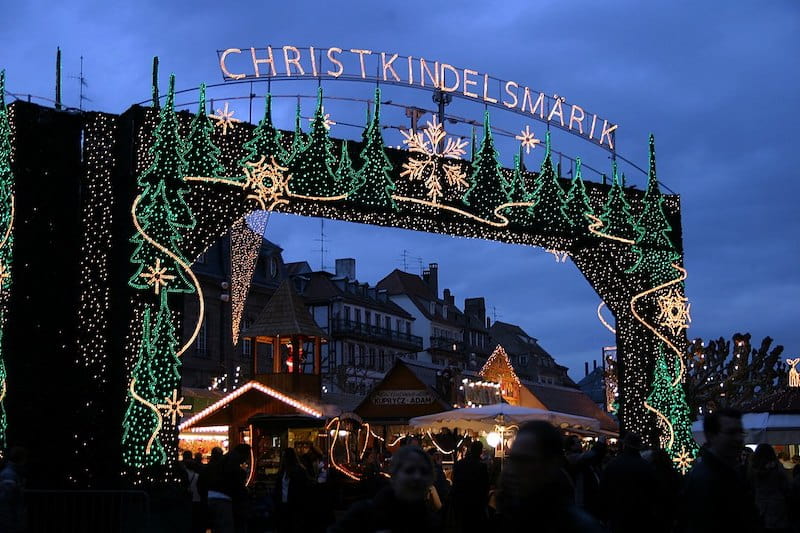 Entrance to the Strasbourg Christmas Market by Rama (Own work) CC BY-SA 2.0 fr
Entrance to the Strasbourg Christmas Market by Rama (Own work) CC BY-SA 2.0 frDO YOU HAVE FRIENDS WHO LOVE CHRISTMAS AND FRANCE?
If you'd like some good Christmas cheer à la française, I've hunted down these French-themed Christmas gifts you can give the francophiles in your life.
Strasbourg Christmas market has a fascinating history.
Not only is it one of the biggest Christmas markets in Europe, but it is France's oldest, dating back to 1570. Some records even show an earlier version of the market back in the late 12th century.
It's no wonder Strasbourg is sometimes called the Capital of Christmas!
Celebrations began here when Strasbourg was part of Germany (where Christmas was celebrated more than in France). The festivities were mostly Catholic but Strasbourg eventually became a Reformation stronghold with a strong Protestant voice, making things a bit uneasy.
Initially held in honor of St Nicholas, who died on 6 December, the "saintly" side of the fair was abandoned and the date moved to three days before Christmas, still giving people time to buy provisions for the feast day. The event was renamed Christkindelsmarkt, or the Market of the Child Jesus, satisfying both Catholics and Protestants.
Many of the traditions stayed and today, Strasbourg is one of the few Christmas markets in the world to celebrate two different cultures, religions and heritages.
Nowadays, France's largest Christmas market has over 300 stalls spread across the city in 10 different venues, selling traditional food, drinks and a lot of festive cheer.
There is also an ice rink, live music performances and plenty of cultural events, all of which you can check out here.
Many travelers combine Strasbourg and the Colmar France Christmas markets, especially if they want to experience both the oldest and the most atmospheric markets in Alsace.
Where to stay in Strasbourg: December sells out fast. Compare hotels near the Strasbourg Cathedral or Petite France if you want to be close to the Strasbourg Christmas market.
A BIT OF STRASBOURG HISTORY
In the heart of the Alsace region, the city has had a roller-coaster history, from Roman defence outpost to free city under the German Holy Roman Empire. Knowing a good thing when he saw it, Louis XV annexed the increasingly prosperous city in 1681.
Then came the French Revolution and widespread destruction, but industrialization was around the corner and the city would rebuild itself.
Strasbourg would still ping-pong between Germany and France until it became French again after World War I. But World War II and the Nazis intervened, annexing the Alsace region until their defeat in 1944.
Today, Strasbourg is home to the European Parliament and the city sees its role as one of reconciliation. It is still in France.
🎄Strasbourg Christmas market 2025 takes place from Wednesday 26 November to Wednesday 24 December.

7. Colmar: the most magical
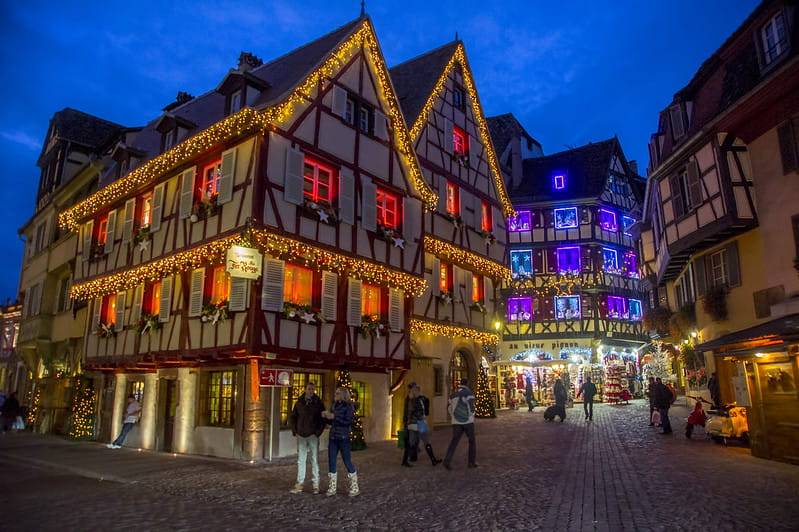 French Christmas markets are garlanded with lights. These lights in Colmar are hard to resist and even in the chill of winter, they seem warm and inviting © Tourisme Colmar
French Christmas markets are garlanded with lights. These lights in Colmar are hard to resist and even in the chill of winter, they seem warm and inviting © Tourisme Colmar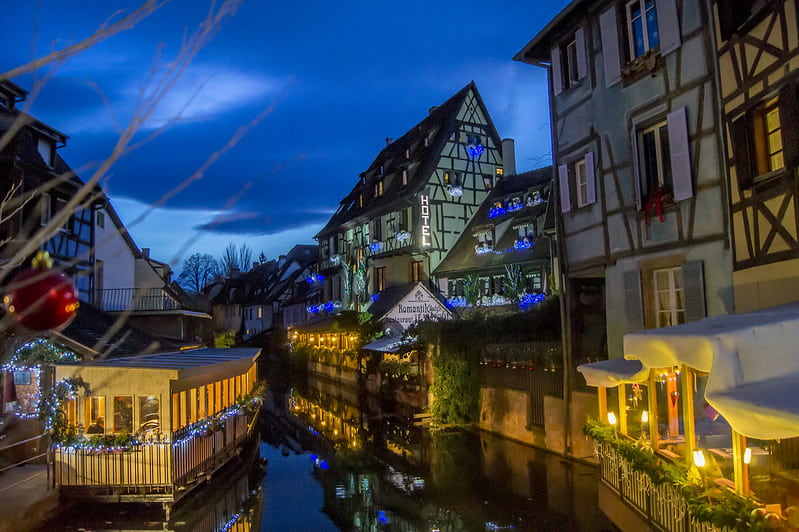 Visitors often compare the Colmar France Christmas markets with Strasbourg because the atmosphere is smaller, warmer and easier to navigate — ideal if you prefer quieter evenings ©Tourisme Colmar
Visitors often compare the Colmar France Christmas markets with Strasbourg because the atmosphere is smaller, warmer and easier to navigate — ideal if you prefer quieter evenings ©Tourisme ColmarWhile Strasbourg's Christmas market is huge and crowded, Colmar's is a little more intimate, made of half a dozen little markets strung together across town.
Even without Christmas, Colmar's half-timbered houses are a draw but during the holiday season, the town is positively enchanting and people come from far and wide to visit.
The more than 1000 Christmas lights and the city's decor have won Colmar a prize from the Academy of Street Arts for its computer-aided fiber optics.
The entire town is decorated for Christmas and because the heart of Colmar is pedestrian, nothing comes between you and the Christmas brightness. It's like walking into a fluorescent constellation.
More information on the Colmar Christmas market.
Where to stay in Colmar: The Colmar France Christmas markets fill up quickly. Compare hotels in Little Venice or around Place des Dominicains for the easiest access to the six market zones.
LITTLE VENICE
A quick look at the canals of the Lauch and you'll understand why this particular part of Colmar is called Little Venice, or Petite Venise.
Historically, this neighborhood was covered in orchards and vegetable farms and proximity to the water allowed barges to moor and pick up produce and deliver it straight to the town's covered market.
🎄Colmar Christmas market 2025 takes place from Tuesday 25 November to Monday 29 December.

8. Kaysersberg: the most artisanal
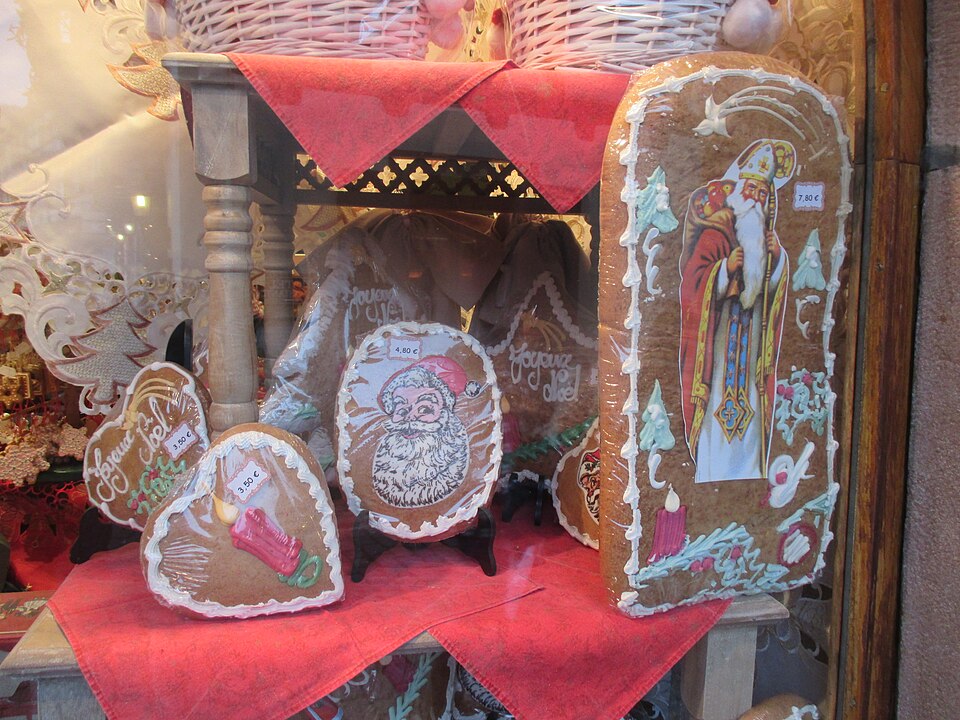 Gingerbread and spiced cookies at the Kaysersberg Christmas market, all made by local bakers. Photo Arnaud 25, CC BY-SA 4.0, via Wikimedia Commons
Gingerbread and spiced cookies at the Kaysersberg Christmas market, all made by local bakers. Photo Arnaud 25, CC BY-SA 4.0, via Wikimedia CommonsJust a few kilometers from Colmar, you'll find one of the most atmospheric artisan markets in France.
Kaysersberg has a strictly traditional market where every stall must offer handmade, locally produced goods. No mass-produced ornaments, no global brands, only regional crafts, food specialities and workshops rooted in Alsatian traditions.
The setting adds to the charm. Kaysersberg’s medieval streets and timbered houses provide a backdrop that feels older and quieter than the larger Alsace markets. The market runs only on weekends, which makes it feel more like a local ritual rather than a major tourist event.
For a closer look at the market, here's the tourist office website.
AN OUTSIZED HISTORY
Kaysersberg may be small, but it has an outsized history.
It’s the birthplace of Albert Schweitzer, the Nobel Peace Prize laureate whose family home still stands near the main street.
The village grew around a 13th-century castle set on a rocky spur, a reminder of the long rivalry between France and the Holy Roman Empire for control of this valley.
At its center is a fortified bridge from 1514, one of the oldest in Alsace, which protected the town’s merchants and shaped its medieval street plan, still intact today.
🎄Kaysersberg Christmas market 2025 runs for four weekends (Fri-Sun) from Friday 28 November 2025.

9. Mulhouse: the best dressed
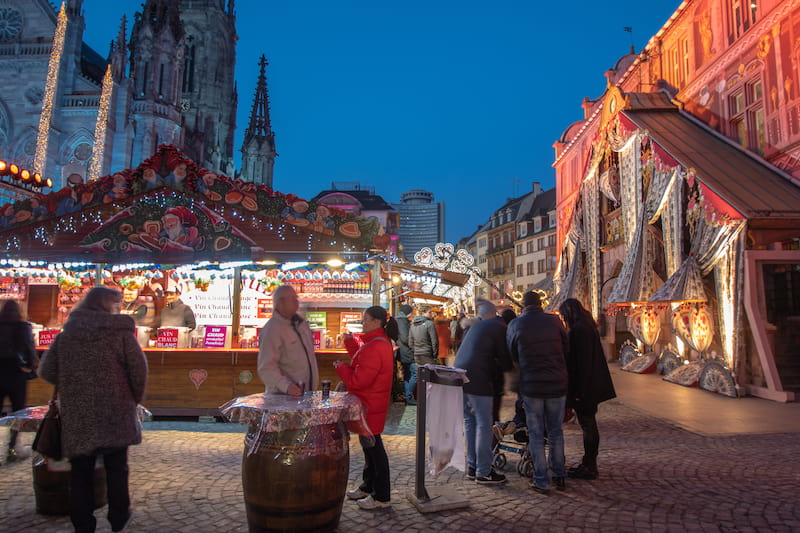 See the lovely cloths on the right? ©BBuhrer / Visit Mulhouse
See the lovely cloths on the right? ©BBuhrer / Visit MulhouseContinuing our travels across eastern France we come to Mulhouse, which dresses up at Christmas.
The Indian cotton industry dates back to 1746 in this city, making Mulhouse one of Europe's textile capitals, abetted by a location at the crossroads of France, Germany and Switzerland.
To celebrate this industrial textile heritage, each year, a new and festive cloth is designed specifically for Christmas. You'll see it throughout the city, where it is used to drape everything from City Hall to Christmas trees to the market's Christmas chalets.
If you stay overnight, consider hotels near Place de la Réunion, close to the textile museum and the market stalls.
And if you're looking for unusual gift ideas, the cloth is also sold at the market.
Here's more information on the Mulhouse Christmas Market.
FOR TRANSPORTATION BUFFS
Once you've visited the Museum of Printed Textiles, a must in Mulhouse, you can turn your attention to transportation because this is where you'll find two unusual museums.
The International Automobile Museum, which houses the prestigious Schlumpf Collection, has no fewer than 400 vintage vehicles, with everything from Bugatti Royales to the first ever automobile, a 1894 Panhard-Levassor.
You don't have to be a car enthusiast to enjoy what may well be the largest automobile museum in the world.
If you prefer your transport on tracks, Europe's largest railway museum, the Cité du Train, retraces two centuries of railway history in France through exhibits, sound and light shows, full steam engines, train station replicas, war history and forerunners of the famed Orient Express.
Like the automobile museum, this is one for the curious visitor and if you've ever traveled by train, this museum may tip you over the edge of nostalgia.
🎄Mulhouse Christmas market 2025 takes place from Friday 21 November - Tuesday 23 December.

10. Montbéliard: the most eclectic
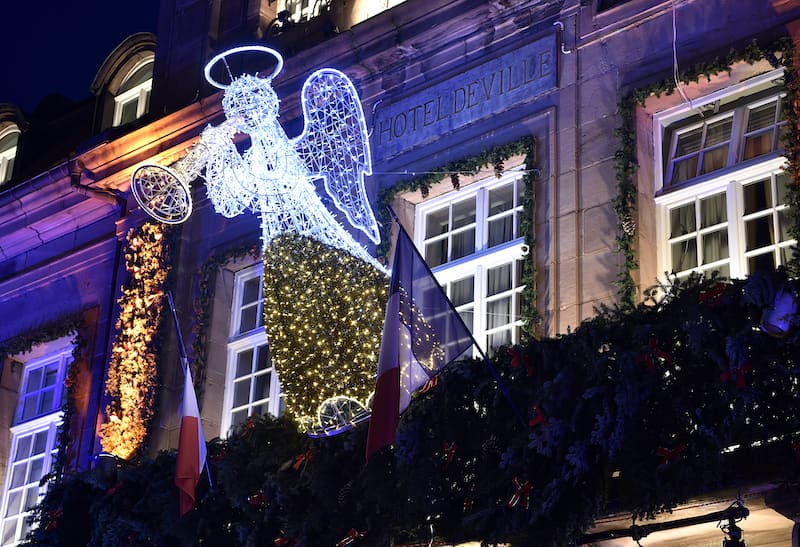 Bright lights of the Montbéliard Christmas market (Denis Bretey – Ville de Montbéliard)
Bright lights of the Montbéliard Christmas market (Denis Bretey – Ville de Montbéliard)Montbéliard is not on every tourist route but given its long Germanic history (it became part of France during the Revolution in 1793), you won't be surprised to find a Christkindlmarkt, or German Christmas market, here.
It's full of surprises, though.
Les Enfants de la Lumière, or children of the light, is a unique choral group of 150 children who perform their songs while wearing crowns of candles on their head – but don't worry, these are battery-operated, no flames are involved. (The tradition comes from Sweden, in honor of St Lucie, patron saint of light.)
Also, Santa Claus has competition here and must share the spotlight with Aunt Airie, the good fairy of Montbéliard. Airie may have been the youngest daughter of a Gaul druid, or perhaps the reincarnation of a 15th-century countess who lived in the local chateau...
Either way you're bound to run into her (or most likely her descendant) as she weaves through the wooden chalets of the Christmas market on her donkey, handing out candies to children.
Here is the official website for the Montbéliard Christmas market.
A PROTESTANT ENCLAVE
When you visit this Christmas market, you can't miss the Temple Saint-Martin (named after Martin Luther).
In the 14th century, there was a Catholic church here. Two centuries later, the city aligned with the Reformation and became a Protestant enclave, surrounded by Catholic territories.
As the city's population swelled with Huguenots, French Protestants fleeing the wars of religion, Prince Frederick I of Wurttemburg called on a famous architect to build a temple on the site. The dates of all this building and shifting religions are a little fuzzy, but we do know that Louis XIV decided to impose Catholicism and destroy non-Catholic places of worship.
The clever citizens of Montbéliard came up with a plan: they added a steeple to their temple and transformed it into a church, thereby saving it.
It is now a historical monument and France's oldest Protestant temple and Reformation-era monument.
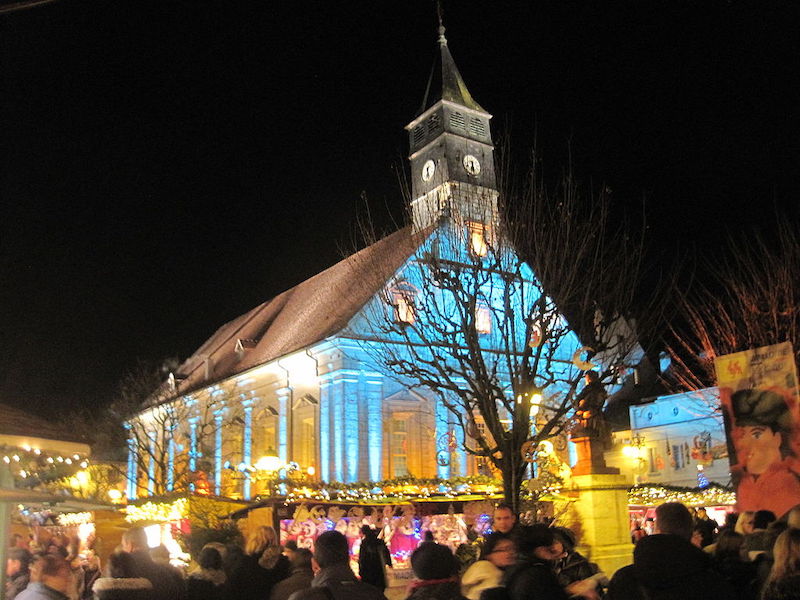 Montbéliard Christmas Market surrounding the Temple (Arnaud 25 / CC BY-SA)
Montbéliard Christmas Market surrounding the Temple (Arnaud 25 / CC BY-SA)🎄Montbéliard Christmas market 2025 takes place from Saturday 22 November to Wednesday 24 December.
This part of eastern France often gets overlooked, yet it has some of the most distinctive Christmas markets France offers, especially for travelers who enjoy local folklore.

11. Evian: the most fairy-like
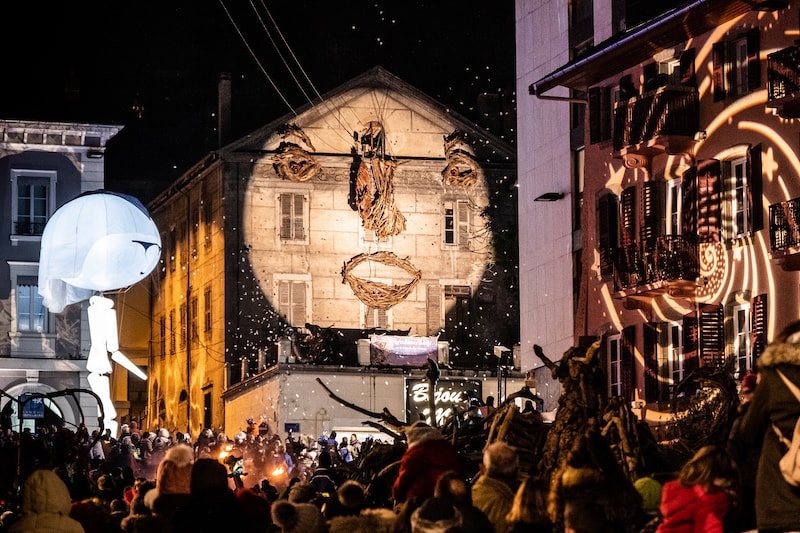 ©Nicolas Castermans
©Nicolas CastermansWhile Montbéliard is about history, the Evian Christmas market is about storytelling at its best.
If I could find an adjective for "driftwood", I'd use it, as in the "most driftwoody" market, but that doesn't really work...
Evian-les-Bains has outdone itself by using what it has at hand: driftwood collected from its shores along Lake Geneva. It has created a Christmas village made of wood and filled it with fairy-tale creatures – elves, genies, sirens and witches – all from driftwood. In French, driftwood is "bois flotté", so the mythical creatures are called "flottins".
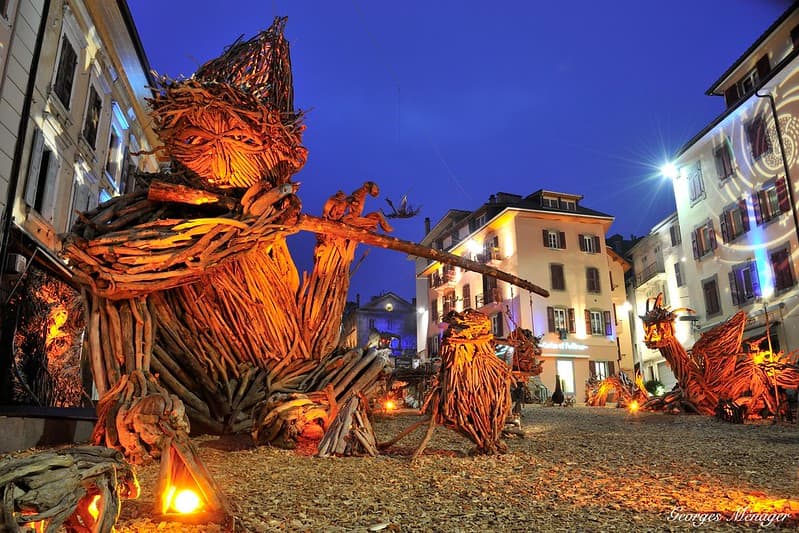
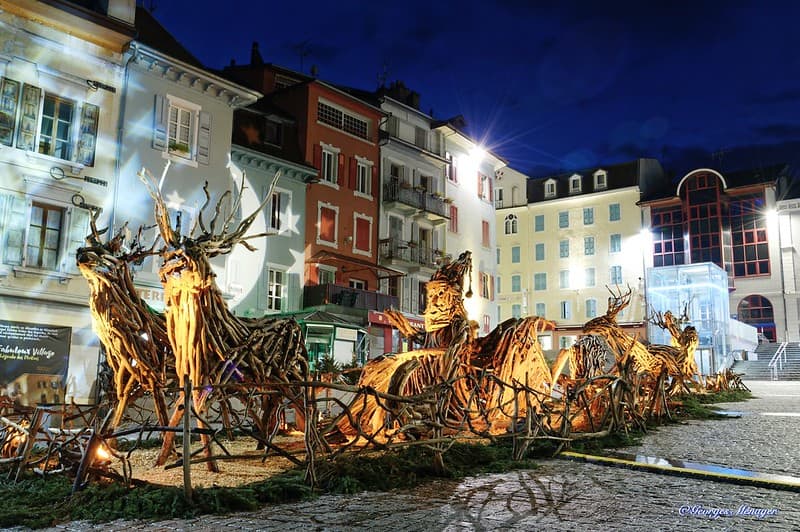 Flottins, made with driftwood during Evian's Christmas Market by Georges Ménager via Flickr CC
Flottins, made with driftwood during Evian's Christmas Market by Georges Ménager via Flickr CC This is no traditional Christmas market with stands but the village is right in the heart of town, so businesses all decorate their shop windows with driftwood to get into the flottin spirit.
Some 350 tons of driftwood are used to make 650 sculptures and at night, everything magically lights up, the brilliance enhanced by torchlights and fireworks. This original idea came from a super-creative local theater troupe, the Theâtre de la Toupine.
And here's more information on the village itself.
EVIAN, HOME OF... EVIAN
Yes, this is the same Evian that bottles the water many of us drink and love. Evian is a popular resort town on the French side of Lake Geneva, a privileged spot among beauty and wealth, made ever so wealthier by the spring water which has become synonymous with its name.
It all began with a liver ailment. A man who was ill drank water from this local spring each day and when he got better, he claimed it was because of the water. Word spread and the spring's owner, Mr Cachat, began charging for the water. He put up a fence to make sure no one helped themselves.
And the people came, flocking to the Source Cachat to "take the waters". The town was then called Evian but changed its name to Evian-les-Bains, or baths, to match its fast-growing reputation as a spa town.
🎄Evian Christmas market 2025 takes place from Friday 12 December to Saturday 3 January 2026.

12. Lyon: the best light show
We're talking about Christmas markets, but in Lyon, the REAL treat is an event that takes place during the market but which is separate from it: the Fête des Lumières, the Festival of Lights.
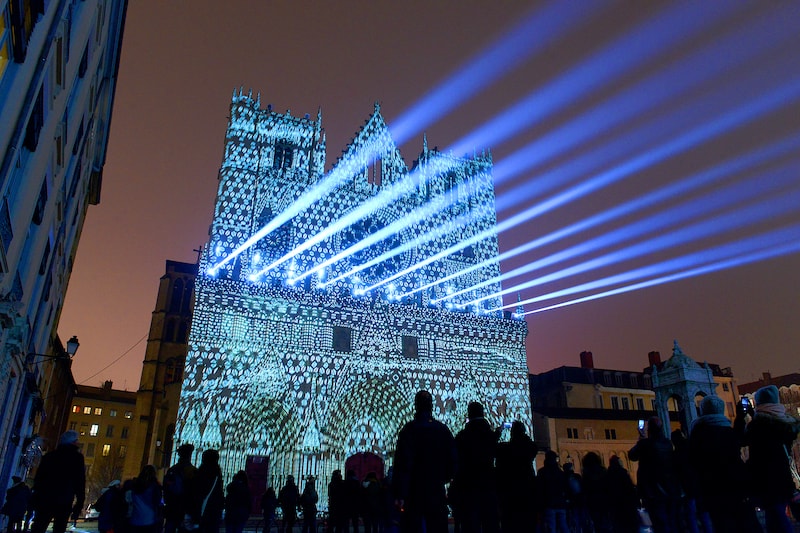 Evolutions - Yann Nguema ©Ville de Lyon - Muriel Chaulet
Evolutions - Yann Nguema ©Ville de Lyon - Muriel Chaulet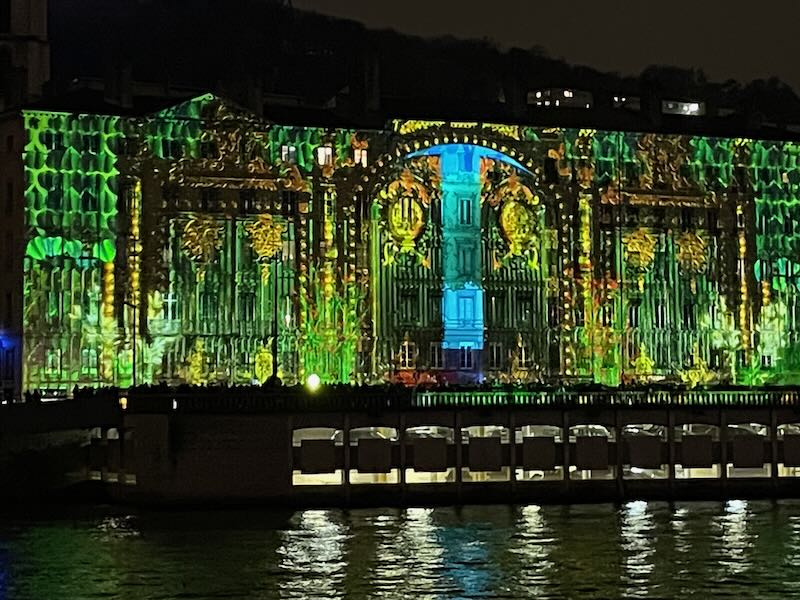 Fête des Lumières in Lyon ©OffbeatFrance
Fête des Lumières in Lyon ©OffbeatFrance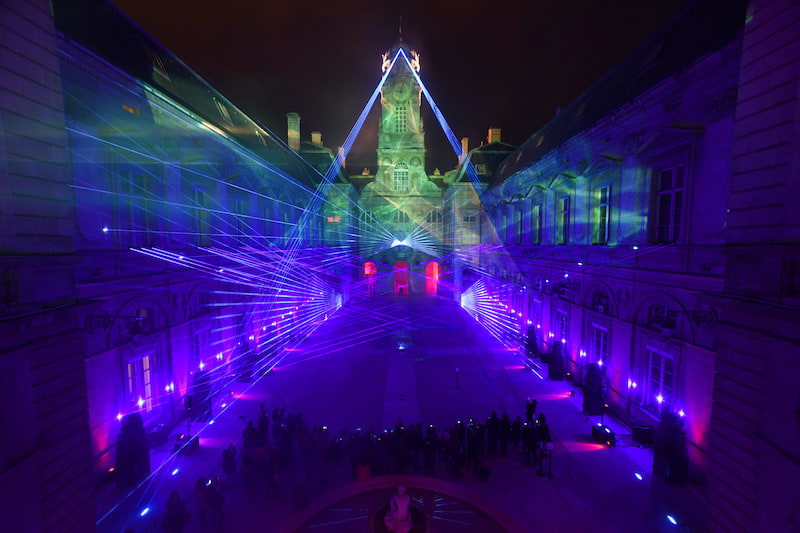 Tricolore - Ralf Lottig ©Muriel Chaulet
Tricolore - Ralf Lottig ©Muriel ChauletWe all love a good light show but this one is more like a spectacular fairy tale, located throughout the city. It is a sophisticated spectacle that will keep your eyes glued to building façades, whatever the chill in the air.
I don't think I've seen anything else like it, with each illumination a true work of art. In fact, the designers of each "act" become known in their own right. (I know that anything by Muriel Chaulet, pictured above, will astonish me.)
As for the Christmas market, you'll find it on the Place Carnot but there's a second market, very much worth seeing, on the hills of Croix Rousse, where Lyon's artisans show off their skills.
Lyon isn’t part of the traditional Alsace itineraries, but many readers include it when planning a broader Christmas markets France loop that mixes culture, food and design.
Here's more on the Festival of Lights and the Lyon Christmas Market.
Where to stay in Lyon: The Festival of Lights draws huge crowds. Compare hotels around Place Bellecour or Presqu’île to stay close to both the market and the illuminations.
AND WHILE YOU'RE IN LYON...
...there are two things I'd like you to visit.
One are the "traboules", the little passageways that take you from one building to the next and which were once used by the city's silk workers to carry bolts of cloth down the hill without getting them wet (and to hide from soldiers who were sent to put down various silk worker rebellions).
Résistance fighters also used them to hide from the Nazis during World War II. There are some 400 traboules, but only about 40 are open to the public (and the tourist office has an app to help you visit).
The other thing you must see are Lyon's extraordinary murals, which are scattered throughout town, with many in the heart of the city. They are true works of art, and some of the larger ones are so intricate you could spend an hour gazing without seeing everything. Most represent some facet of the city and its history.
🎄Lyon Christmas market 2025 takes place from Saturday 29 November to Wednesday 24 December.

13. Foire aux Santons in Aix-en-Provence: the most Provençal
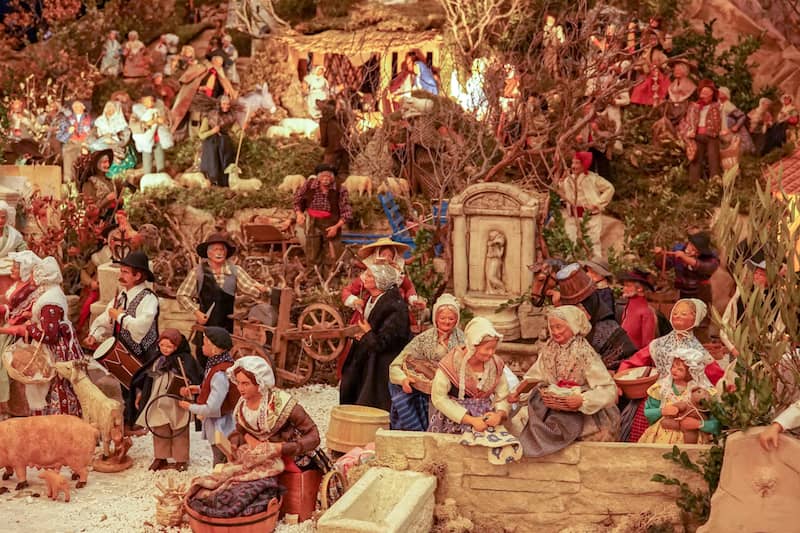
Southern France may not seem like a typical winter wonderland, but the Santons of Provence are a local tradition dating back to the 18th century.
The tiny terracotta figurines, or santons, were originally created to play out miniature nativity scenes when traditional ones were outlawed during the French Revolution.
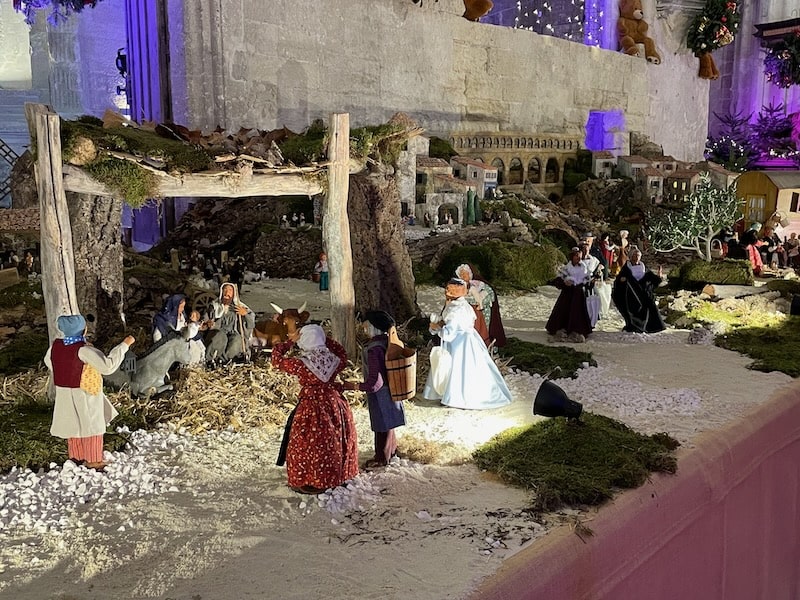 One of the many santons fairs in southern France at Christmas ©OffbeatFrance
One of the many santons fairs in southern France at Christmas ©OffbeatFranceToday, these nativity figurines are a much-loved part of Christmas festivities in the South of France and you can find markets entirely dedicated to both the santons and the artists that create them, with one of the best markets located in Aix-en-Provence.
The foire aux santons (santons fair) started here in 1934 and still takes place from late November to the end of December every year.
You'll find it in the centre of Aix-en-Provence, running alongside the annual Christmas market, which starts at the Place de la Rotonde and spreads down the city's central boulevard, Cours Mirabeau.
Here you'll find santonniers selling their creations, often displayed reenacting everything from traditional nativity scenes to full-blown village life including fishmongers, bakers and farmers.
For the Santons fair, look for hotels near Cours Mirabeau, where most events take place.
Any market in Aix-en-Provence is a joy but the santons fair is an excellent way to both appreciate this unique cultural aspect of Provence, and to pick up some very special treasures to take home with you.
AIX IN ROMAN TIMES
The city of Aix-en-Provence, once known as Aquae Sextiae, was the first Roman settlement in what is present-day France. Contrary to other Roman cities, this one was populated in large part by Gauls arriving from nearby towns.
It is famous for the Battle of Aquae Sextiae in 102 BC, when Germanic and Nordic tribes swept down into southern Gaul and were repelled by the Roman Consul, Caius Marius.
The Greek writer and philosopher Plutarch immortalized this battle in his Life of Marius. Thousands were taken prisoner and it is said that the women chose suicide over slavery. Aix is a well-known thermal center but less known is that it was already so in Antiquity, since several Roman thermal ruins have been found.
🎄Aix-en-Provence Christmas market 2025 takes place from Friday 14 November to Wednesday 31 December.

14. Bordeaux Christmas market, banking on social issues
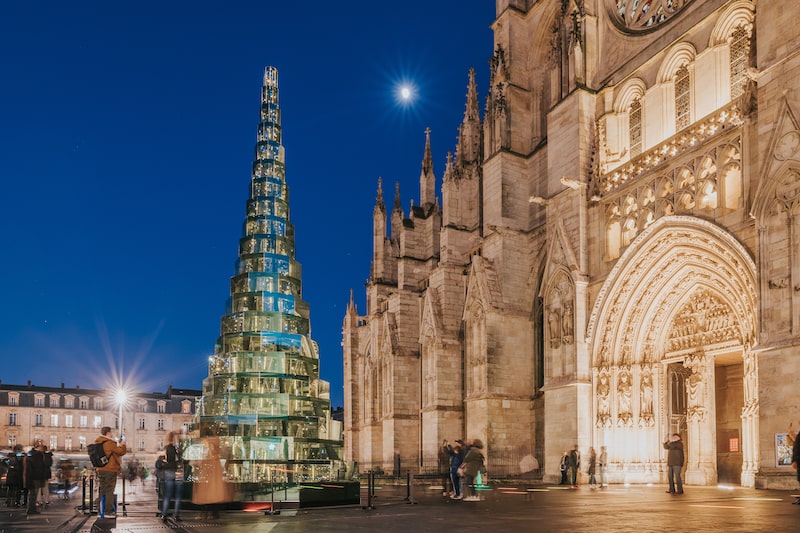 This glass and steel Christmas tree replaced the traditional "real" Christmas tree after the election of a left-leaning mayor. The move has not been without controversy. Travelers sometimes look for Christmas markets in Nice France or other coastal cities, but Bordeaux remains the most established option in the southern part of the country with a strong local identity. Photo ©Nicolas Duffaure
This glass and steel Christmas tree replaced the traditional "real" Christmas tree after the election of a left-leaning mayor. The move has not been without controversy. Travelers sometimes look for Christmas markets in Nice France or other coastal cities, but Bordeaux remains the most established option in the southern part of the country with a strong local identity. Photo ©Nicolas DuffaureOur final stop is at the annual Christmas market in Bordeaux, which prides itself on being environmentally conscious and socially aware.
The entire market is accessible, and the city encourages everyone to use public or soft transportation. All containers are recyclable or reusable, food is sourced locally, and plenty of charitable associations are allowed to take part.
Of course none of this hampers the festive spirit that takes hold of the city this time of year! And while you're here, take the time to visit the city, one of the prettiest in France.
Bordeaux stays lively in December. Check out central hotels near Allées de Tourny, a short walk from the Christmas market.
Find out more about the market here.
🎄Bordeaux Christmas market 2025 takes place from Friday 28 November to Sunday 28 December.

FAQ
When do Christmas markets open in France?
When do Christmas markets open in France?
Most Christmas markets in France open towards the end of November, the 3rd or 4th weekend, and go through to the end of December or sometimes, early January. Check official dates before you travel because dates often change each year.
Which Christmas markets are the best in France?
Which Christmas markets are the best in France?
Alsace has the oldest and largest markets, especially Strasbourg and Colmar, but France also has unique Christmas markets such as sustainable Roubaix, driftwood-filled Evian, and the candlelit streets of Montbéliard.
Are Christmas markets open on Christmas Day?
Are Christmas markets open on Christmas Day?
Not usually. Most markets close on 25 December, although some reopen on 26 December or continue through the weekend. Larger cities may keep food stalls open, but shopping chalets are usually shut.
Are flea markets open at Christmas in France?
Are flea markets open at Christmas in France?
Sadly, most are closed in winter, or scale back during the colder season. Large cities such as Paris, Lyon and Lille still hold weekend flea markets, but opening hours depend on weather and demand.
CONTRIBUTING AUTHORS
Paris Tuileries by Elisa from World in Paris | Strasbourg by Kathryn Bird from Wandering Bird | Aix-en-Provence by Nadine Maffre from Le Long Weekend
Before you go...
Christmas is a wonderful time in France, whether you celebrate the holiday or not.
The cheer, the lights, everything conspires to brighten things up. If you're curious about Christmas in France, find out what French people eat for Christmas! It may not be what you think...
Essential France travel resources
BOOK YOUR ACCOMMODATIONS
I use booking.com: for their huge inventory and for their easy cancellation policies
FLIGHT DELAYED OR CANCELED?
AirHelp can get you compensation (it works, I've used it)
DO YOU NEED AN E-SIM CARD FOR FRANCE?
Here's the one I use when I travel anywhere
PROTECT YOUR BELONGINGS
Keep pickpockets away with an anti-theft purse or an infinity scarf - and your identity with a VPN (I'm using Nord VPN)
TRAVEL INSURANCE
Travelers recommend Visitors' Coverage or SafetyWing. for health away from home
GETTING FROM A TO B
I use Discovercars to rent cars and either Omio or RailEurope for train tickets
TO READ ABOUT FRANCE
Here's my long list of books about France
AND DON'T FORGET...
To bring a guidebook for France!
Did you enjoy this article? I'd love if you shared it!

